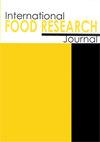红白火龙果自发发酵过程中酵母多样性分析
IF 1
4区 农林科学
Q4 FOOD SCIENCE & TECHNOLOGY
引用次数: 0
摘要
对红白火龙果自发发酵过程中的酵母菌群落进行了表征和比较,为火龙果酵母菌的分离提供参考。利用Illumina MiSeq高通量测序技术,研究了火龙果自发发酵的5个阶段(1、3、5、7和15 d)酵母群落的组成和多样性,结果显示红火果和白火龙果分别有584,055和699,120个有效序列。将序列划分为86和42个操作分类单位,分别归属于红火龙果49属69种和白火龙果32属37种。分类组成和多样性分析结果表明,红火龙果自发发酵初期(RF1)和白火龙果自发发酵中期(WF5)酵母多样性较高。红火龙果的优势酵母菌种为未分类的o_saccharomycetales,白火龙果的优势酵母菌种为Clavispora opuntiae,在红白火龙果发酵过程中,优势酵母菌种呈相反趋势。单因素方差分析显示,红火龙果中unclassified_o_Saccharomycetales (p≤0.01)和白火龙果中Clavispora opuntiae (p≤0.001)在5个自然发酵阶段差异极显著。此外,系统发育分析显示unclassified_ocharomycetales和Clavispora opuntiae离其他酵母菌最远。总体而言,红火龙果自发发酵过程中酵母群落多样性高于白火龙果。本文章由计算机程序翻译,如有差异,请以英文原文为准。
Analysis of yeast diversity during spontaneous fermentation of red and white pitaya
Yeast communities during spontaneous fermentation of red and white pitaya were characterised and compared to provide a reference for the isolation of pitaya yeast strains. Using Illumina MiSeq high-throughput sequencing technology, we investigated the composition and diversities of yeast communities during five stages of spontaneous fermentation (1, 3, 5, 7, and 15 d), and the results showed 584,055 and 699,120 valid sequences from red and white pitaya, respectively. The sequences were classified into 86 and 42 operational taxonomic units, then assigned to 69 species in 49 genera (red pitaya) and 37 species in 32 genera (white pitaya). Taxonomic composition and diversity analysis results showed high yeast diversity during the early stage of spontaneous fermentation (RF1) for red pitaya, and during the middle stage (WF5) for white pitaya fermentation. The dominant yeast species was unclassified_o_Saccharomycetales in red pitaya, and Clavispora opuntiae in white pitaya, and these species showed opposite trends during red and white pitaya fermentation. One-way ANOVA showed highly significant differences in unclassified_o_Saccharomycetales (p ≤ 0.01) in red pitaya, and in Clavispora opuntiae (p ≤ 0.001) in white pitaya across the five spontaneous fermentation stages. In addition, phylogenetic analysis revealed that unclassified_o_Saccharomycetales and Clavispora opuntiae were positioned farthest from other yeast species. Overall, yeast community diversity during spontaneous fermentation was higher in red rather than white pitaya.
求助全文
通过发布文献求助,成功后即可免费获取论文全文。
去求助
来源期刊

international food research journal
Agricultural and Biological Sciences-Food Science
CiteScore
1.40
自引率
0.00%
发文量
75
期刊介绍:
The International Food Research Journal (IFRJ) publishes papers in English, six (6) issues a year with the coverage of:
Food Science and Technology
Nutrition and Dietetics
Agriculture, multidisciplinary
Chemistry, multidisciplinary
The scope of the Journal includes:
Food Science, Food Technology and Food Biotechnology
Product Development and Sensory Evaluation
Food Habits, Nutrition, and Health
Food Safety and Quality
Food Chemistry, Food Microbiology, Food Analysis and Testing
Food Engineering
Food Packaging
Food Waste Management
Food Entrepreneur
Food Regulatory
Post-Harvest Food Management
Food Supply Chain Management
Halal Food and Management
 求助内容:
求助内容: 应助结果提醒方式:
应助结果提醒方式:


